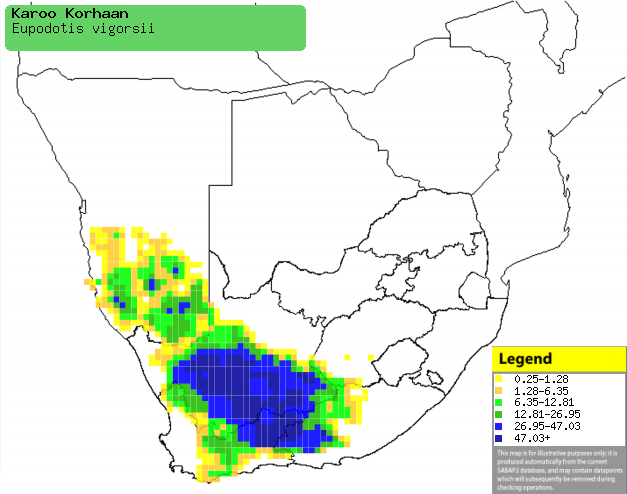|
Eupodotis vigorsii (Karoo
korhaan)
Vaalkorhaan [Afrikaans]; Zwartkintrap [Dutch]; Outarde
de Vigors [French]; Namatrappe [German]; Abetarda do Karoo [Portuguese]
Life
> Eukaryotes >
Opisthokonta
> Metazoa (animals) >
Bilateria >
Deuterostomia > Chordata >
Craniata > Vertebrata (vertebrates) > Gnathostomata (jawed
vertebrates) > Teleostomi (teleost fish) > Osteichthyes (bony fish) > Class:
Sarcopterygii (lobe-finned
fish) > Stegocephalia (terrestrial
vertebrates) > Tetrapoda
(four-legged vertebrates) > Reptiliomorpha > Amniota >
Reptilia (reptiles) >
Romeriida > Diapsida > Archosauromorpha > Archosauria >
Dinosauria
(dinosaurs) > Saurischia > Theropoda (bipedal predatory dinosaurs) >
Coelurosauria > Maniraptora > Aves
(birds) >
Order: Gruiformes
> Family: Otitidae
Distribution and habitat
Endemic to southern Africa, occurring from southern Namibia
to the Northern, Western and Eastern Cape. It generally prefers dwarf arid
shrubland of the Nama Karoo and succulent Karoo, especially with stony ground,
while in the Western Cape it also occurs in cultivated land.
|
 |
|
Distribution of Karoo korhaan in southern Africa,
based on statistical smoothing of the records from first SA Bird Atlas
Project (©
Animal Demography unit, University of
Cape Town; smoothing by Birgit Erni and Francesca Little). Colours range
from dark blue (most common) through to yellow (least common).
See here for the latest distribution
from the SABAP2. |
Predators and parasites
Movements and migrations
Resident and sedentary.
Food
Mainly eats invertebrates, reptiles and plant matter, doing
most of its foraging by walking along the ground while plucking up food items. The following food items have been recorded
in its diet:
- reptiles
- insects
- plants
- seeds, pods, fruits, flowers, leaves and bulbs
- Solanaceae
- Asteraceae
- Chenopodiaceae
- Atriplex semibaccata (Creeping saltbrush)
Breeding
- Monogamous, often breeding in family groups with a breeding pair and other
helpers, who help to defend the territory.
- The nest is a shallow scrape in the scrape in the ground, usually among
scattered shrubs and rocks.
- Egg-laying season is from June-February, peaking from December-January.
- It lays a single egg, which is incubated solely by the female, who
sometimes temporarily leaves the nest to go foraging with the male.
- Little is known about the development and care of the chicks, other then
that they leave the nest soon after hatching.
Threats
Not threatened, although vulnerable to farming activities
on the Agulhas Plain, Western Cape, which can lead to the death of chicks and
eggs.
References
-
Hockey PAR, Dean WRJ and Ryan PG 2005. Roberts
- Birds of southern Africa, VIIth ed. The Trustees of the John Voelcker
Bird Book Fund, Cape Town.
|
